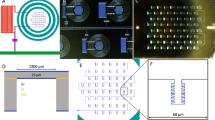Abstract
The high-resolution mid-infrared spectrometer (HIRMES) under development for Stratospheric Observatory for Infrared Astronomy is an instrument operating in the 25–122 μm spectral range with a spectral resolution R = Δλ/λ ~ 100,000 and has two absorber-coupled transition edge sensor bolometric detector focal planes. We have developed novel NbTiN low-stress absorber coatings which have the required optical impedance across the HIRMES operating band. The low intrinsic stress of these coatings allow for a peak-to-valley corrugation amplitude < 5 μm of the 450 nm thick, 1.4 mm × 1.7 mm detector pixels. Furthermore, these coatings have a superconducting transition temperature ~ 10 K, which allows them to simultaneously serve as an absorber in the desired signal band and a rejection filter at long wavelengths. This attribute makes them especially attractive for ultrasensitive absorber-coupled bolometric detector applications, because it helps in controlling the optical loading from out-of-band radiation. We also discuss a novel method for integrating a wedged-reflective absorber termination to the detector array.




Similar content being viewed by others
References
https://www.nasa.gov/feature/nasa-selects-next-generation-spectrometer-for-sofia-flying-observatory
A.-D. Brown et al, J. Low Temp. Phys. This Special Issue (2018)
C. Allen, D.J. Benford, T.M. Miller, S.H. Moseley, J.G. Staguhn, E.J. Wollack, J. Low Temp. Phys. 151, 266–270 (2008). https://doi.org/10.1007/s10909-007-9646-9
C.A. Jhabvala et al., SPIE Proc. 9153, 9153C1–9153C12 (2014). https://doi.org/10.1117/12.2056995
D.J. Benford, D.T. Chuss, G.C. Hilton, K.D. Irwin, N.S. Jethava, C.A. Jhabvala, A.J. Kogut, T.M. Miller, P. Mirel, S. Harvey Moseley, K. Rostem, E.H. Sharp, J.G. Staguhn, G.M. Stiehl, G.M. Voellmer, E.J. Wollack, 5,120 superconducting bolometers for the PIPER balloon-borne CMB polarization experiment. SPIE Proc. 7741, 77411Q (2010)
B. Carli, D. Iorio-Fili, Absorption of composite bolometer. J. Opt. Soc. Am. 71, 1020–1025 (1981)
The actual membrane-backshort separation distance may have been much shorter due to membrane curvature
E.J. Wollack, D.T. Chuss, S.H. Moseley, Electromagnetic considerations for pixellated planar bolometer arrays in the single-mode limit. SPIE Proc. 6275, 62750V (2006)
Z. Yapu, Stiction and anti-stiction in MEMS and NEMS. Acta Mech. Sinica 19, 1–10 (2003)
W.D. Greason, Review of the effect of ESD in MEMS, in Proceedings of the 2010 ESA Ann. Meeting on Electrostatics, University of North Carolina, Charlotte, June 22–24, 2010
M.J. Li et al., Electrostatic microshutter arrays, in Transducers 2017 Conference, the 19th International Conference on Solid-State Sensors, Actuators and Microsystems, Kaohsiung, Taiwan, June 18–22, 2017
Acknowledgements
This work was supported by a SOFIA Third Generation Instrument Award. The authors gratefully acknowledge suggestions and discussions with Kevin Denis. Funding was supported by ROSES Solicitation NNH15ZDA001N-S3GSI, proposal number 15-S3CSI_CSR_0003.
Author information
Authors and Affiliations
Corresponding author
Rights and permissions
About this article
Cite this article
Miller, T.M., Brown, AD., Costen, N. et al. A Path to High-Efficiency Optical Coupling for HIRMES. J Low Temp Phys 193, 681–686 (2018). https://doi.org/10.1007/s10909-018-1939-7
Received:
Accepted:
Published:
Issue Date:
DOI: https://doi.org/10.1007/s10909-018-1939-7




